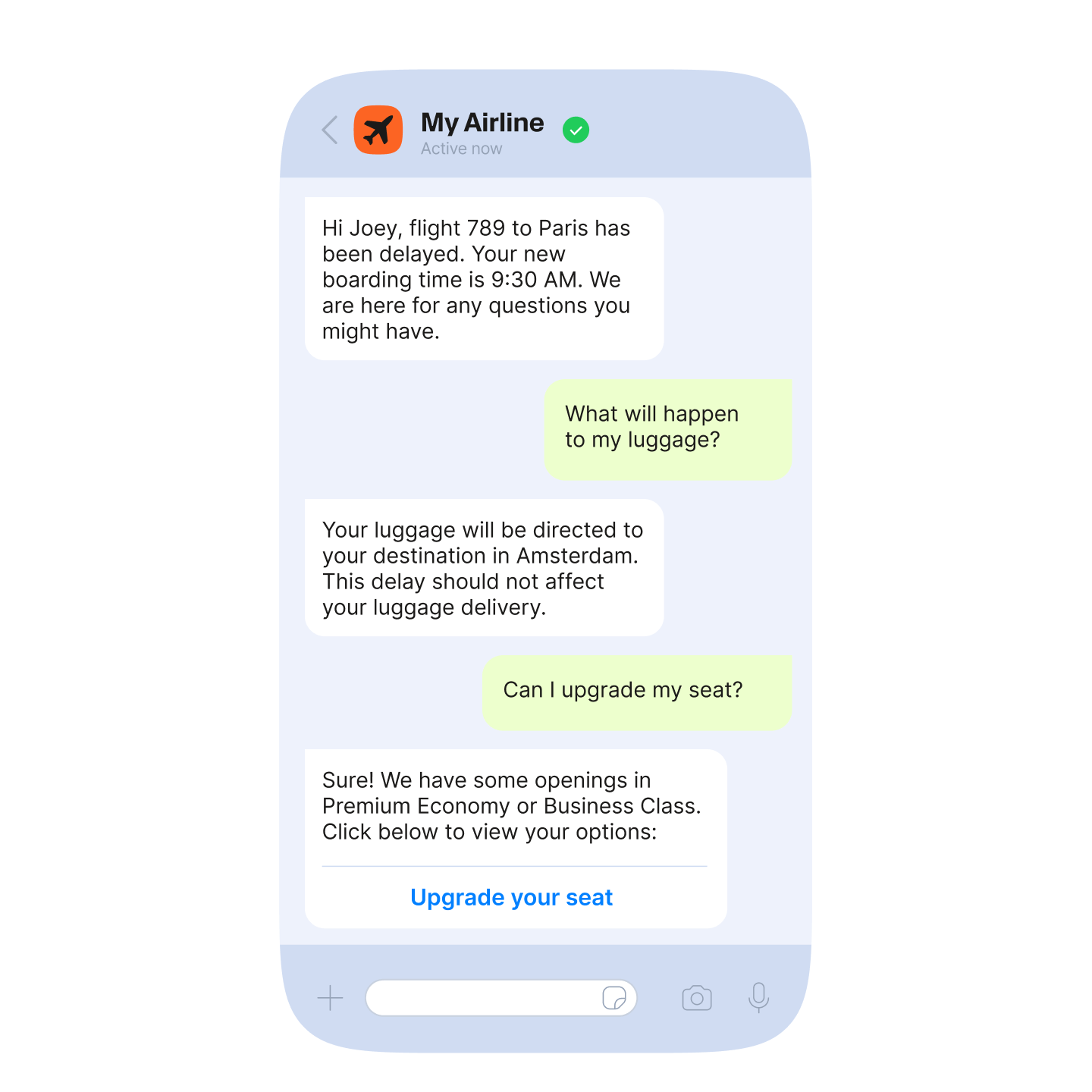How to improve airline disruption management and crisis communication
Learn how communication platforms enable the aviation industry to better manage crisis situations, flight disruptions, and cancellations with real-time passenger updates.

In recent months, flight delays and cancellations have surged around the world, disrupting millions of air travelers and putting both airlines and airports under intense operational pressure. For the aviation industry, the consequences go far beyond logistics — they impact customer satisfaction, reputation damage, and operational costs.
Just recently, over 300 flights were cancelled or delayed across Europe’s three busiest hubs — London Heathrow, Amsterdam Schiphol, and Paris Charles de Gaulle — due to various operational issues:
- Staffing shortages
- Gate allocation delays
- Ground handling problems
- Tight aircraft rotations at congested airports
As global travel continues to rise and challenges like weather, labor unrest, and air traffic control restrictions persist, one thing is clear: airlines need smarter, faster ways to communicate when things go wrong. Effective crisis management and smart disruption management systems aren’t just a nice-to-have — they’re essential for building resilience, trust, and long-term customer loyalty.
What airline passengers expect in the face of disruptions and crisis
Today’s passengers don’t just want to get from point A to B — they want clear, fast updates when plans change. Whether it’s a delay, cancellation, or missed connection, travelers expect airlines to communicate early, often, and through the channels they already use.
Here’s what recent data from Gitnux shows passengers expect:
- 75% appreciate proactive communication about delays and cancellations
- 92% prefer messaging platforms for support
- 75% value real-time flight schedule and time updates during their journey
- 84% say customer experience is just as important as ticket price
For airlines, these stats highlight more than just expectations — they point to a real opportunity. With the right tools in place, it’s possible to meet these needs while also driving cost savings, reducing inbound pressure on support teams, and delivering a more unified passenger experience.
What does an effective airline crisis communication strategy look like?
Modern communication platforms give airlines the control they need to handle disruptions in real time and at scale. When operations are under pressure, speed and clarity are critical — and automation can turn a messy situation into a coordinated, controlled response.
Here’s how airlines can use a communication platform to be set up to support their disruption management strategy:
Omnichannel message delivery: Meet passengers where they are
Passengers have different preferences — and those preferences shift based on urgency, region, and travel habits. A truly global communication platform allows airlines to send updates across:
- SMS for fast, reliable delivery
- WhatsApp for international travelers
- In-app notifications for loyalty program members
- Email for confirmations and detailed updates
- Social media for mass alerts and public updates
Use case: A storm causes delays at a major airport. The airline sends:
- Immediate SMS alerts to affected travelers
- WhatsApp messages with rebooking links for international flyers
- Push notifications via the airline app with gate changes and new boarding times

This omnichannel setup ensures passengers receive the message — no matter where they are or how they booked.
Fallback channel reliability: No one left behind
Not all messages get delivered the first time — especially when passengers have phones on airplane mode or lack data. That’s where fallback channels come in.
Use case: An Italian traveler at Newark Airport has their flight cancelled, but their phone is on airplane mode.
- The platform first sends an SMS (as it’s fast and reliable)
- It fails to deliver, so the system triggers a WhatsApp message
- The traveler receives rebooking instructions and a hotel voucher — avoiding long waits or confusion

Fallback strategies like this are a must for maintaining service continuity and building trust in high-pressure situations.
Real-time flight data integration: No manual intervention needed
By integrating flight management systems (FMS) or reservation systems, communication platforms can trigger messages automatically based on operational events.
Use case: An aircraft swap causes a 45-minute delay. The system sends:
- An SMS alert to all passengers
- A follow-up with the new gate number
- An alert when the gate is open and boarding has begun

No manual steps. No gaps in communication. Just real-time, accurate time updates passengers can rely on.
Segmentation and personalization: Speak to the right audience
Not every passenger on a flight is impacted in the same way. Segmenting your outreach ensures messages are relevant — and prevents unnecessary stress.
You can segment by:
- Route and destination
- Loyalty tier or cabin class
- Special assistance needs
- Connection time and airport
Use case: A delayed flight risks missed connections. The airline:
- Prioritizes alerts for short-connection passengers with rebooking options
- Sends lounge access and meal vouchers to those with longer layovers
- Offers alternate routing to business class flyers

This type of personalization builds confidence and helps airlines avoid mass confusion.
Automation during peak times: Scale support without sacrificing service
When large-scale disruptions hit — like weather events, system outages, or strikes — contact centers can’t keep up. Automation helps maintain order while reducing the burden on staff.
Use case: An IT failure grounds several flights. The airline:
- Sends a WhatsApp message via chatbot offering refund or rebooking options
- Resolves the majority of passenger queries without human support
- Routes only complex cases to live agents — minimizing wait times

The result: lower costs, faster service, and a better experience for both passengers and agents.
Infobip’s CXOP as an airline disruption management solution
Infobip’s Conversational Experience Orchestration Platform (CXOP) helps airlines move from reactive messaging to proactive, automated support — with AI at the center.
Here’s how CXOP supports smarter crisis communication and flight disruption handling:
1. Autonomous, AI-led passenger support
CXOP uses agentic AI that can take autonomous actions across channels — like sending alerts, answering questions, and even escalating to human agents when needed.
Example: A flight gets cancelled. Based on data inputs (ie. API) Agentic Agents detect the cancellation and message passengers across their preferred channels, offers rebooking links, and handles replies and questions without human intervention
This dramatically improves response time and consistency.
2. Orchestration across channels and systems
CXOP integrates with core aviation authority and airline systems — like CRMs, loyalty databases, and reservation systems — while managing communication across in-app, email, chat apps, and voice.
That means travelers get seamless updates whether they’re in the airport, in transit, or halfway through their journey.
3. Intelligent workflows and automation
CXOP lets you create intelligent workflows triggered by real-time events like weather alerts, flight cancellations, or ground crew shortages. It can:
- Notify passengers with personalized messages
- Offer dynamic rebooking options or vouchers
- Alert internal teams for coordination
The future of airline communication is autonomous
Disruptions are a reality of modern aviation. But chaos doesn’t have to be.
With platforms like Infobip’s CXOP, airlines can turn unpredictability into opportunity — delivering faster updates, more helpful support, and greater customer satisfaction even during peak stress moments.
In a competitive aviation industry, how you communicate when things go wrong may matter more than how you perform when everything goes right. Case studies continue to show that investing in proactive, AI-powered communication leads to stronger brands, smarter operations, and more loyal passengers.








